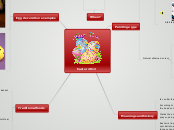u
Leavening Agents (what are they)
Leaving agents are ingredients that help the air (or gas) that cuases bread, cakes, and other baked goods to rise when they enter into the oven. (4 types)
"Unsung"
Sweetners: Ex: Dry sugars will capture more air then any liquid ( For example: White sugars vs honey).
Liquids that creat steam: This will use any CO2 as a gas to produce an expanision. Steam is simply water vapour produced with the water in dough reaches atleast 100C (212F)
When water becomes steam its volume increases by 1500x
Eggs: Most recipes that need eggs have then beaten up until they're light and lemon colored- That would be a signal that they've incorporated air into them.
If you beat eggs with a fat ( e.g: Creaming eggs and butter) you produce a emolision that can hold more air tgen either alone.
Fats: The leavening actions is altered by how you incorporate fat into the dough/batter. Creaming butter and sugar together (With an electric mixer) incorporates air into the mixture.
Oils will produce a heavier product as it does not contain as much air as butter. The liquid of butter ont he other hand also expands and turns to steam (helps with expansion.
Flour: Aerated (or sifted) flour will add air into a recipe, creating a much lighter starting point.
sifted flour should always provide you with a larger (measured) product then unsifted.
Biological
This Leavening provides flavor.
Ot is a single organism (a type of fungus) responsible for the process of frementation: Which is where yeast eats sugar and then produces CO2.
Active dry yeast: Dry, granular yeast that is "Poofed" (activated) By dissolving it in the warm water.
Instant dry yeast: Graular yeast that can be mixed directly into any falvor where no "Poofing" is required. DO NOT use as much as active dry yeast.
Fresh Yeast: Comes in 11b bricks and can be added directly onto dough or can be dissolved into water
Examples of fresh yeast: Yeast bread or rolls, pizza dough.
Mechanical
This Leavening agent requires a readily forcoming ingredients that are capable of retaining air bubbles.
Ex: Egg whites
Leavening by air is trapped in the product through vigorous beating
Ex: Angel food cakes, sponge cakes.
Chemical
Baking Soda- Another name: Sodium Bicarbonate
-PH of 8-9, which is what it makes it a base.
When this ingredient is combined with at acidic ingredient, it will produce a chemical reaction that causes it to release CO2 (Carbon Dixoide)
It can be activated by buttermilk, lemon juice, yogurt, sour cream, etc.
This ingredient is DIFFERNT then Baking powder:
baking powder remains inactive until it is mixed with a liquid. It is less immediate reaction then baking soda so it won't rise as much as Baking soda itself.
Muffin and Biscuit Methods
Biscuit Method
"Not so perfect" Biscuits
Not so perfect Biscuits should be like the following + Causes of the problems.
(1) Dense Biscuits/ No layers --> Due to too much liquid, or over kneading the biscuits
(2) Small Biscuits --> Due too the biscuits being too far apart on the pan
(3) biscuits didn't rise --> Due to oven temperature being low
(4) Flat biscuits --> Due to twisting the biscuit cutter.
perfect Biscuit
The perfect Biscuits should look like the following:
1: Golden brown
2: Flaky layers
3: Evenly risen
The Biscuit method :
-Used for mixing most biscuits and scone recipes
-Butter or fat is "cut in" to the flour mixture, where then the liquids are added
-Where the butter and/or fat should be cold
-Where the heat of the oven melts down the butter, and the water in the butter creates steam--> So it can produce a rise into flaky layers.
Steps:
1: Sift the dry ingredients into 1 bowl
2: "Cut in" the fat with a pasty blender until the mixture is granular, where the particles are almost the size of peas
3: Combine liquid ingredients together in a separate bowl
4: Add Liquids to dry ingredients, then stir until combined
5: Remove the dough to a counter that is lightly dusted with flour (so it doesn't stick). Then knead the dough 10-12 times. DO NOT OVERMIX!
6:Cute dough into shapes that you like, then bake it.
Muffin Method
Method
Steps:
1: Sift together the dry ingredients into 1 bowl
2: Sift together the wet ingredients into 1 bowl
3: Combine both dry and wet together (DON'T OVER MIX)
4: Stir both ingredients together, not too much.
"Not so perfect" Muffin
The Non so perfect muffins should look like the following + causes of the problems:
(1) Pale --> Due to the oven being cool
(2) Peaked and smooth on top --> Due to overmixing
(3) Tough and heavy --> Due to overmixing or too much flour
(4) Uneven texture with tunnels --> Due to Overmixing
(5) Dry --> Due too too much flour or the oven being too hot
(6) Stuck to the pan/paper liner --> Due to not enough fat
(7) Dark crust but center not cooked --> Due to oven being too hot or a Dull or dark pan.
Perfect Muffin
The perfect muffin should look like the following:
1: Golden brown
2: Tender and light
3: Even textured with medium round holes
4: A moist inside
5: Easy to remove from the pan
Ingredient Review
Flavoring: This Ingredient enhances flavor of a product
Example: spices, herbs, extracts (i.e. vanilla)
Salt: This Ingredient enhances flavor of other ingredients and controls the action of yeast.
Leaveners: This ingredient is a combination of other ingredients together.
Air, Steam, CO2
Produce: helps a product start to rise and become lighter, and pourous
Sugar: This ingredient adds color to a product of because burning or caramelization, It increases tenderness (absorbs water which prevents gluten from developing.) This Ingredient also adds flavor.
Eggs: This Ingredient holds and/or binds other ingredients into one. It adds flavor, nutrients, and color.
Fat: This ingredient tenderizes products by interfering with the gluten ingredient. It can also affect the flavor of the product.
Examples: Oil, butter, margarine, shortening, lard
Liquid: This Ingredient is needed to develop gluten in flour. It Provides solvent for dry ingredients and steam for leavening.
Example: Milk, water, juice, eggs, flavoring, oil, melted fat
Flour: This ingredient provides gluten, a protein substance and helps form an elastic stand when mixed with a liquid. It helps give structure.
Combining Ingredients
Rolling: This Method requires us to a rolling pin to roll out the dough evenly on a floured surface so it doesn't stick.
Kneading: This method requires you to use your hand to fold dough over on itself. Push down and away with the heels of you palm. Turn it 1/4 after each push
Cutting In: This Method requires a pastry blender to cut solid fat into dry ingredients until it's the size of small peas.
Or rolled oats
Tossing: This Method is most likely used with a fork to life up any ingredients.
Not always used with a fork though
Folding: This Method is used with a Rubber spoon to cut vertically through any mixture. To slide ingredients across the bottom, up the sides, and turning it over.
Like folding paper
Beating, Whipping: This method is used with either a wooden spoon, whisk, or a beater in a rapid, fast, circular motion to combine the ingredients to add air.
Stirring, Combing, Mixing: This Method is used with a Wooden Spoon, to distribute ingredients in a circular and a fast motion.
Creaming: This Method is when you rub/press fat and sugar against the side of the bowl to make softer.
Types of Flour
Stiff dough 1:4
Liquids= 1 (250 ml)
Flour= 4 (1000 ml)
Examples: Gingerbread dough, and short bread
Soft Dough 1:3
Liquids= 1 (250 ml)
Flour= 3 (750 ml)
Examples: Biscuits and bread
Thick Batter 1:2
Liquids= 1 (250 ml)
Flour= 2 (500 ml)
Examples: Muffins, cookies
Thin Batter 1:1
Liquid= 1 (250 ml)
Flour= 1 (250 ml)
Examples: Pancake and crepes.









